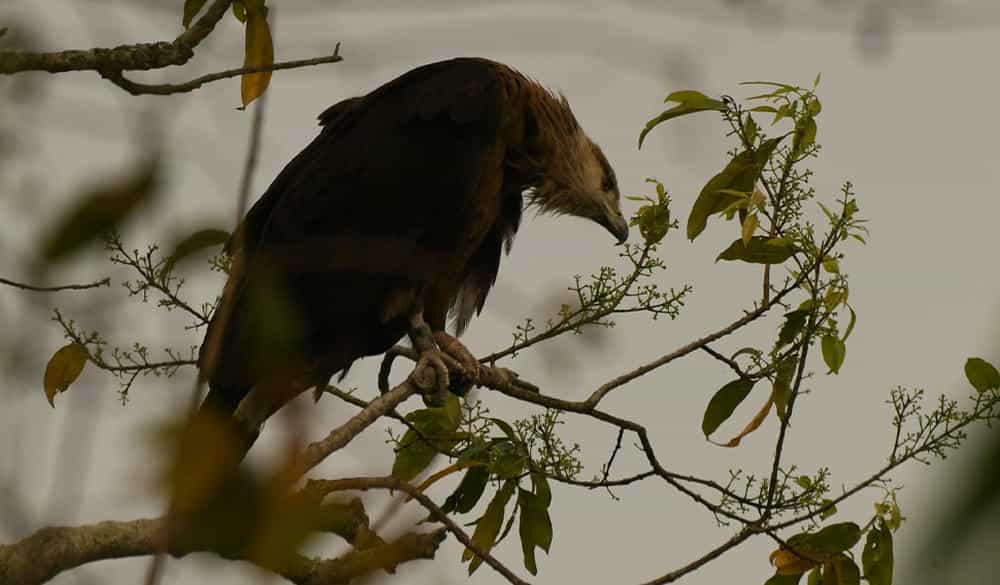Endangered Eagle from Mongolia returns to Kaziranga for 5th year, cementing Assam’s role in global bird migration

A Pallas’s Fish Eagle, a globally endangered species, has returned to Kaziranga National Park for the fifth consecutive year, underlining the critical role the park plays in the Central Asian Flyway—a key migratory route for birds from Central Asia to the Indian subcontinent.
The eagle, a male named Ider, was first tagged with a numbered ring (A 25) by ornithologist Dr. Batmunkh at Buuntsagaan Lake in Central Mongolia on August 21, 2020. Scientists from the Bombay Natural History Society (BNHS) spotted the bird again on March 16 this year in Kaziranga, confirming through global registries that it is the same individual. Since being tagged, Ider has made an annual journey of over 4,000 kilometres to breed in Kaziranga during the winter months, returning to Mongolia for the summer.
The Pallas’s Fish Eagle (Haliaeetus leucoryphus) is among the least-studied raptors globally and is currently classified as “Endangered” on the IUCN Red List, with fewer than 10,000 mature individuals left in the wild. What makes Ider’s journey notable is the eagle’s reverse migration pattern—it breeds in India during winter and migrates north to Mongolia during summer. Kaziranga is one of the few places globally where this rare eagle can reliably be seen.
“Kaziranga is emerging not just as a sanctuary for iconic mammals, but also as a global refuge for endangered migratory birds,” said a BNHS researcher involved in the sighting.
Situated at the heart of the Central Asian Flyway (CAF)—a major migratory corridor that spans 30 countries from Siberia to the Maldives—India serves as a crucial stopover for over 370 migratory bird species. Of these, 310 species depend primarily on wetlands. The diverse habitats of Kaziranga, with over 50% of its area covered in wetlands, grasslands, and riverine systems, make it a magnet for these travellers.
Kaziranga Tiger Reserve (KTR), a UNESCO World Heritage Site, has long been celebrated for its “Big Five” mammals, but birders know it for its rich avifauna—over 500 species, including 124 waterbird species counted in the 6th Kaziranga Waterbird Count conducted in January 2024.
That survey recorded 112,062 individual birds across 189 beels (oxbow lakes), including 62 winter migrants. Among the key sightings were the Critically Endangered Baer’s Pochard and the Endangered Pallas’s Fish Eagle, both indicators of high conservation value.
Assam Chief Minister Himanta Biswa Sarma also acknowledged Ider’s return, tweeting, “The endangered Pallas’s Fish Eagle, tagged in Mongolia, has made Kaziranga its breeding ground for 5 straight years, putting Assam on the map of epic bird migrations. Witnessed these winged wonders.”
The Chief Minister’s statement reflects growing recognition of Kaziranga’s importance not just for tourism or tigers, but as a keystone in international conservation efforts.
Despite India’s critical position on the CAF, less than 1% of its bird species have been tracked via satellite telemetry, leaving major gaps in understanding bird migration patterns. Scientists urge that more resources be allocated to study migratory species, especially those like the Pallas’s Fish Eagle, which are rapidly declining.
Kaziranga, along with Laokhowa and Burhachapori Wildlife Sanctuaries, form two Important Bird Areas (IBAs) in Assam that act as safe havens for migratory birds. The continued return of Ider not only affirms the ecological integrity of these wetlands but also raises the stakes for their protection.
As migratory birds face increasing threats from habitat loss, climate change, and pollution, success stories like that of Ider highlight the immense value of well-managed protected areas. Kaziranga, with its long conservation legacy, is proving to be more than a stronghold for rhinos—it’s a lifeline for species flying in from half a world away.





Leave a Reply